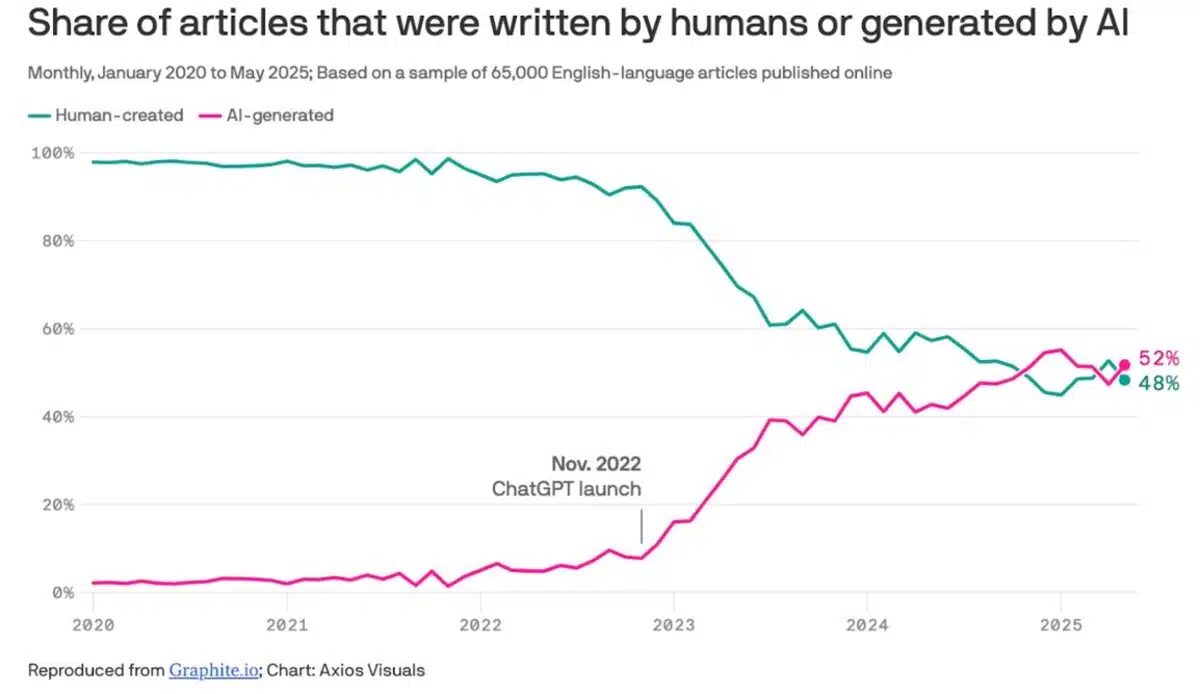Search has always been a game of cat and mouse. In the early days, simple tricks won: white text on a white background, hidden links, keyword stuffing, and paying for links. Those were black hat tactics because they worked — for a while. Early algorithms were blunt instruments and sites that exploited them climbed the ranks.
Now the instruments are smarter. Large language models power the next generation of search, and with them comes a new breed of manipulation. The tools are faster and cheaper, and where there’s speed and scale, shortcuts follow.
Why the AI content boom tempts bad actors
AI adoption is soaring. Up to 21% of U.S. users access tools like ChatGPT, Claude, Gemini, Copilot, Perplexity, and DeepSeek more than ten times a month, and overall adoption jumped from 8% in 2023 to 38% in 2025. Those numbers explain a lot. Brands want visibility. They want it now. Standards and best practices are still being worked out, and that creates a vacuum where temptation breeds.

We’re seeing the results. The share of articles written by AI now exceeds those by humans, according to recent reporting. That doesn’t mean every AI-written piece is bad. It means the bar for originality and credibility is under stress. Two years ago, Sports Illustrated used AI and fake bylines. It didn’t increase traffic. It damaged trust. That’s the rub: shortcuts rarely buy real authority.
The new black hat GEO playbook — tactics to watch
AI hasn’t invented black hat SEO. It’s simply industrialized it. Here are the main tactics gaining traction now, each one tuned to how modern search and LLMs interpret content.
Mass AI-generated spam and PBNs
LLMs can auto-produce thousands of keyword-stuffed articles and whole websites. The objective is volume: create enough thin pages to inflate link authority and capture long-tail search traffic. Private Blog Networks are back — only now they’re built at scale and without much human oversight.
Fabricated E-E-A-T signals
Google still points to E-E-A-T — experience, expertise, authoritativeness, trustworthiness — as a core signal. Bad actors forge those signals with AI: synthetic author personas, generated headshots, fake credentials, and armies of fabricated reviews. The pages may look comprehensive at a glance, but they lack human-validated experience beneath the surface.
LLM cloaking and schema misuse
Cloaking has evolved from hiding text to serving an AI-optimized version of a page to crawlers while humans see something else. Misused schema markup can misrepresent a page’s purpose, pushing it into AI-generated answers or rich snippets where it doesn’t belong. Imagine pages falsely tagged as “5-star product reviews” with no real reviews — a deceptive nudge at CTR and ranking features.
Preference manipulation attacks
This is the nastiest and most subtle one. Adversarial content is injected into the web to bias LLM retrieval and reasoning. Research shows a successful attack can make a targeted product 2.5 times more likely to be recommended by an LLM when users ask for a recommendation. That’s not a small edge; it’s a systemic tilt.
Classic tactics, now supercharged
Old tricks haven’t died; they’ve been turbocharged. Link schemes and buying links are simply easier and cheaper with AI. Look at the J.C. Penney case: over 2,000 links to dresses pages from thin sites created for backlinking purposes. The result? A heavy Google penalty and top keywords falling from page one to ranks 70 or lower. Imagine doing that at scale. AI makes building large, deceptive link networks trivial — and the fallout can be catastrophic.
So what does Google do about it?
Google’s message hasn’t changed: high-quality, original content that demonstrates real experience and expertise wins. E-E-A-T remains the framework. Algorithms are getting better at detecting scale and automation. The platforms that power search are learning to spot patterns that signal mass-generated spam, fabricated credentials, and adversarial manipulation.
But detection happens after the fact. Penalties are real and severe. Brands risk loss of traffic, search visibility, and, perhaps worst of all, brand credibility. Reputation is sticky; once it’s damaged, it’s costly to repair.
The sustainable path forward
There’s a tempting short path: spin up a fleet of AI-written pages, fake the signals, and pray the algorithm doesn’t notice. It’s a gamble that rarely pays off in the long run.
Best practices still win. Focus on genuine E-E-A-T. Invest in original reporting, real author experience, and human editing that transforms AI assistance into something authentic and verifiable. Use AI to augment, not replace, human insight. Verify claims, vet sources, and build relationships that lead to natural, manual links — not mass-produced backlink farms.
Algorithms may be smarter, but they’re reflective of human judgments about quality. Give users real value and you’ll be on the right side of history. Cut corners and you’ll face penalties and eroded trust.
Final thought
AI has changed the battleground, but it hasn’t changed the rules that matter most: authenticity, expertise, and honest effort. Want to share a story about a site hit by manipulation or a recovery success? Drop a comment below. Tell us what you think or ask a question. Follow Outreach Bee on Facebook, X (Twitter), or LinkedIn to stay updated on link-building best practices and to join a conversation that values real craft over shortcuts.
Before you go, learn how Google’s BlockRank breakthrough offers smarter search for everyone.
Sources
- www.searchengineland.com/black-hat-geo-pay-attention-463684
- www.seocasestudy.com/seo-examples/black-hat-seo
- www.bluehost.com/blog/black-hat-seo-techniques/



Is It Safe to Tweak Your Site for SEO? Google Says Yes—But Here’s the Catch
The Overlooked SEO Power of Social Media Backlinks